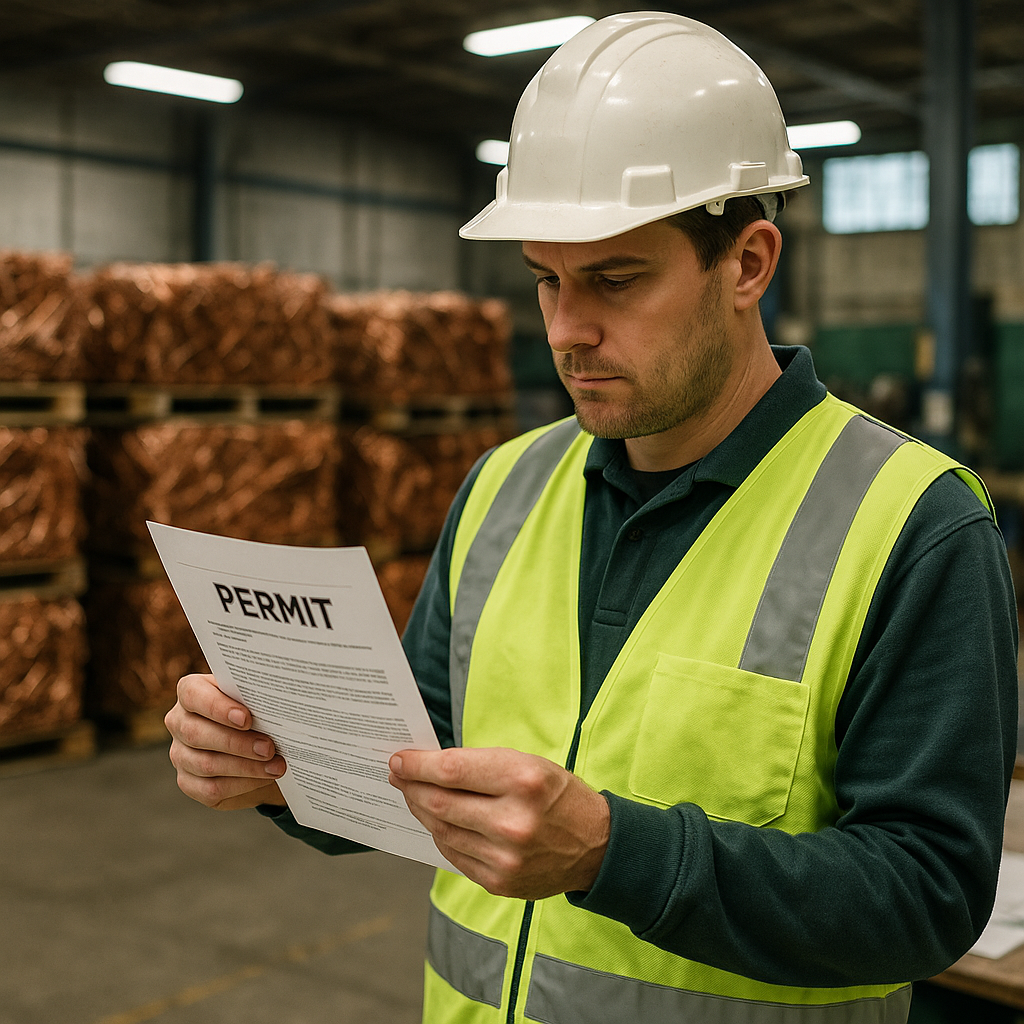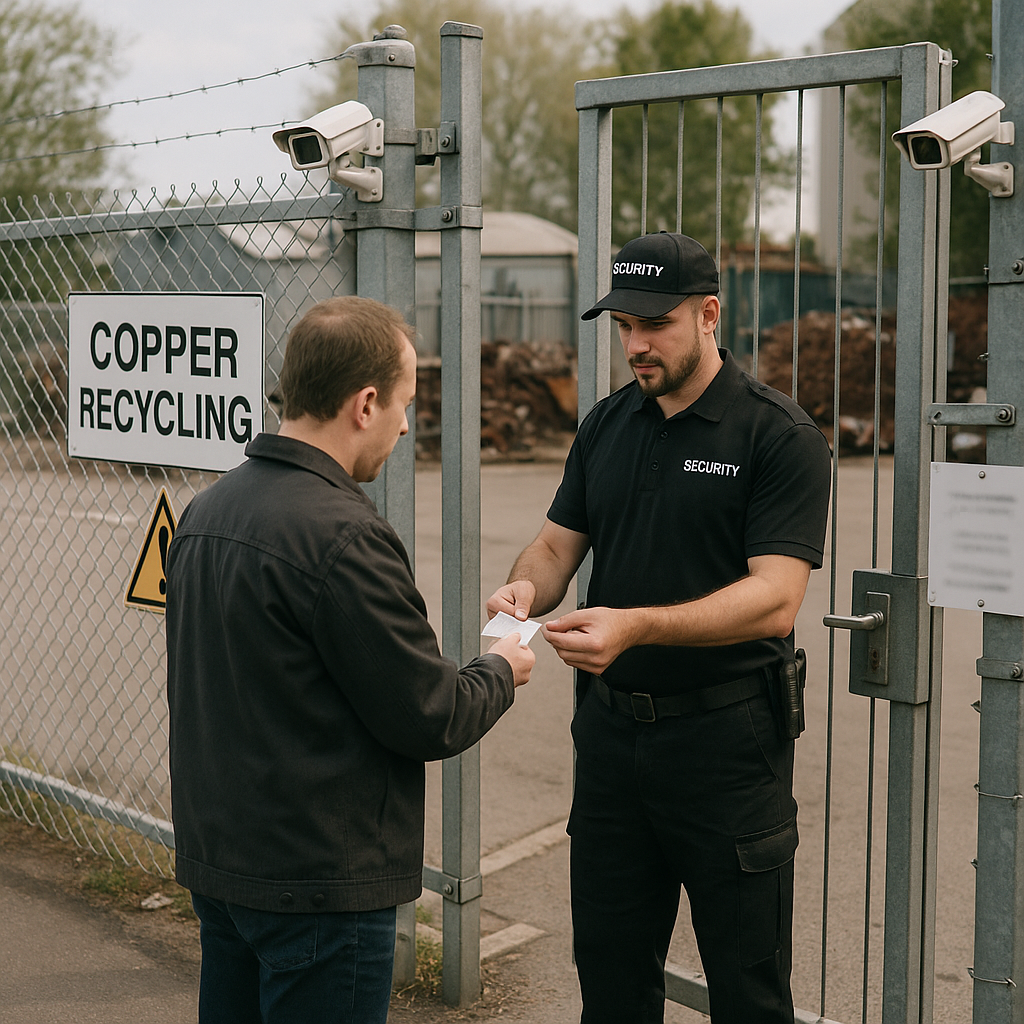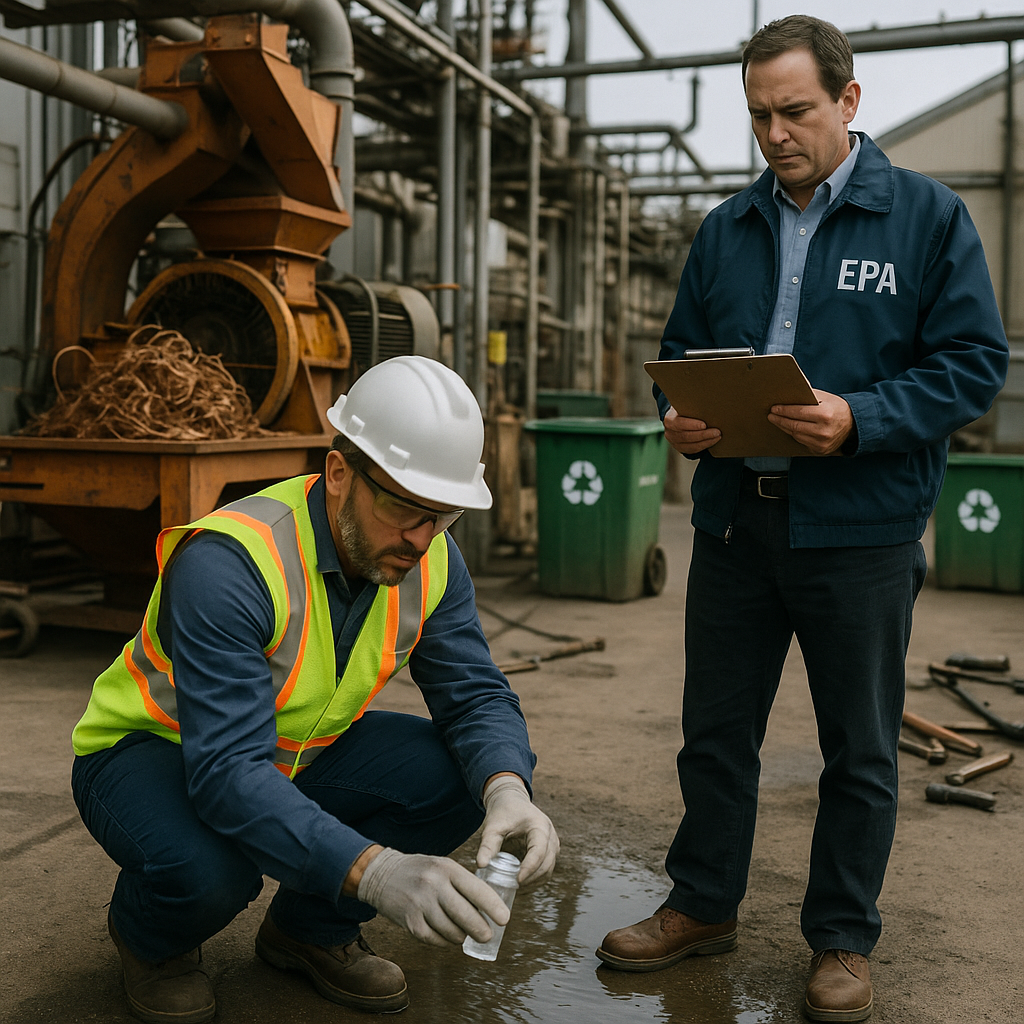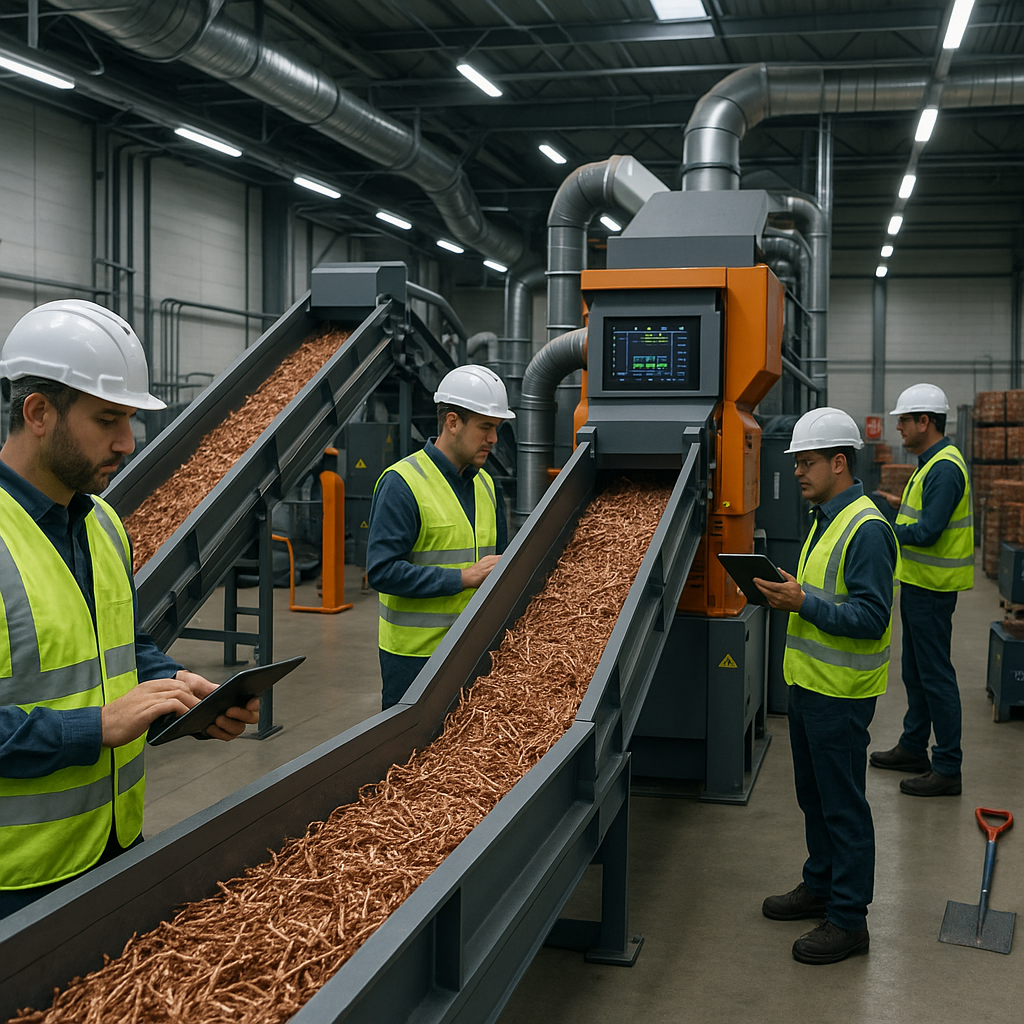5901 Botham Jean Blvd, Dallas, TX 75215
What Are the Key Copper Recycling Compliance Requirements?
May 27, 2025Copper recycling is crucial for both environmental sustainability and regulatory compliance. As one of the most valuable recyclable metals, copper requires careful management within a framework designed to protect businesses, communities, and the environment.
The compliance landscape for copper recycling varies by location. Although regulations differ across countries and regions, they generally aim to prevent illegal trading, deter theft, and minimize environmental impact, resulting in similar regulatory frameworks worldwide.
Five key compliance areas govern copper recycling operations. First, permits and licensing requirements ensure only qualified operators handle this valuable resource. Second, anti-theft measures address the rising issue of copper theft from infrastructure. Third, rigorous documentation and reporting standards track material movement. Fourth, environmental regulations manage processing methods to prevent pollution. Finally, import and export restrictions govern the cross-border movement of copper scrap.
How do permits and licensing requirements affect copper recyclers?

Copper recyclers must navigate a complex network of permits and licenses to operate legally. These requirements vary significantly across states, municipalities, and local jurisdictions. Most regulatory frameworks mandate that recycling facilities register with the appropriate authorities and maintain current documentation of their operations.
The permitting process typically involves submitting detailed applications that outline operational procedures, facility specifications, and compliance measures. Recyclers must demonstrate they have adequate systems for material handling, environmental protection, and record-keeping. Often, facilities must undergo site inspections before permits are granted.
Licensing requirements directly impact daily operations by establishing baseline standards for conducting business. These standards often include specific protocols for material acceptance, storage, and processing. For instance, some jurisdictions require specialized sorting techniques or specific equipment specifications.
Starting January 1, 2025, new legislation in Minnesota will require anyone recycling scrap metal copper for profit to obtain a state-issued license. The application process is straightforward with a $250 fee, though licensed electricians and certain trade groups are exempt from this requirement.
Proper documentation is another critical compliance aspect. Recyclers must maintain detailed records of all transactions, including seller identification, material descriptions, quantities, and payment methods. These records must typically be preserved for extended periods—often three years or more—and made available for inspection upon request.
Environmental regulations further shape licensing terms for copper recyclers. Facilities must implement measures to prevent contamination and manage potentially hazardous materials. This might include containment systems, wastewater management protocols, or air quality control measures. Environmental compliance is increasingly scrutinized as sustainability concerns grow.
The financial implications of licensing are substantial. Beyond application fees, recyclers face ongoing costs to maintain compliance, including staff training, equipment upgrades, and regular audits. Non-compliance carries severe consequences, ranging from monetary penalties to license suspension or revocation. In extreme cases, operators may face criminal charges for willful violations.
Renewal processes add complexity. Most permits require periodic renewal, during which recyclers must demonstrate continued compliance with all regulations. This often involves submitting updated documentation, undergoing inspections, and paying renewal fees.
Navigating these requirements demands significant resources and attention from recycling operations. Many facilities designate compliance officers or departments specifically to manage permitting and licensing obligations. Industry associations often provide guidance and resources to help recyclers stay informed about changing requirements and best practices.
The strategic implementation of compliance measures can provide competitive advantages. Recyclers with robust compliance programs often build stronger relationships with regulators, experience fewer operational disruptions, and develop reputations as responsible industry participants. This can translate into business opportunities, particularly as larger corporations increasingly prioritize partners with demonstrated regulatory compliance.
What anti-theft measures are required for copper recycling?

Anti-theft measures are crucial for regulatory compliance in copper recycling operations. The high value of copper makes it a frequent theft target, necessitating stringent protocols throughout the recycling process. Recyclers must implement comprehensive systems to protect their operations and the integrity of the broader metals market.
Ownership Verification Systems
Recycling facilities must establish robust verification procedures to confirm the legitimate ownership of incoming copper materials. This typically includes requiring valid identification from sellers and documenting the source of materials. Some facilities use specialized software that flags suspicious transactions based on quantity, condition, or seller history.
Recent legislation in several states has strengthened these requirements. Starting January 2025, some regions will require anyone recycling copper for profit to obtain a state-issued license, adding accountability to the supply chain. Licensed electricians and certain trade groups may receive exemptions, but the core purpose remains preventing stolen materials from entering legitimate recycling streams.
Transaction Documentation Requirements
Detailed record-keeping is a critical anti-theft measure. Recyclers must maintain comprehensive transaction logs that include seller information, material descriptions, weights, and payment details. These records serve multiple purposes in combating metal theft.
Most regulations require these transaction records to be retained for several years. The documentation must be readily accessible for inspection by regulatory authorities or law enforcement agencies investigating potential metal theft cases. Some jurisdictions have implemented electronic reporting systems for more efficient monitoring of metal transactions across multiple facilities.
Law Enforcement Cooperation
Effective cooperation with law enforcement agencies is crucial for anti-theft compliance. Recycling facilities must establish clear communication channels with local police departments and respond promptly to inquiries about potentially stolen materials. Some recyclers participate in alert networks that share information about recent thefts in their area.
This cooperative relationship helps authorities track down stolen copper and identify theft patterns. Advanced facilities may implement holding periods for certain types of copper materials, allowing time for law enforcement to cross-reference recent theft reports before processing. This waiting period has proven effective in recovering stolen utility copper and industrial materials before they enter the recycling stream.
Technology-Based Security Measures
Modern recycling facilities increasingly rely on technology to strengthen anti-theft protocols. Security cameras throughout receiving areas create a visual record of all transactions. Some facilities have implemented specialized material tracking systems that help maintain chain-of-custody documentation from receipt through processing.
Payment restrictions represent another technology-enabled security measure. Many jurisdictions limit cash payments for copper transactions, requiring electronic transfers that create additional documentation. This payment trail helps authorities track potentially suspicious transactions and discourages thieves seeking anonymous cash payments.
These anti-theft measures benefit the entire recycling ecosystem by protecting legitimate businesses from unwittingly participating in illegal activities. They help maintain market stability by ensuring materials enter the recycling stream through proper channels. Most importantly, they demonstrate the industry’s commitment to responsible practices that support both environmental and community goals.
How do environmental regulations impact copper recycling operations?

Environmental regulations significantly influence copper recycling facilities by setting comprehensive standards for pollution control and waste management. These regulations aim to minimize the environmental impact of recycling operations while ensuring sustainable resource recovery.
Copper recycling facilities must adhere to strict air quality standards to reduce emissions during processing. Regulations often require advanced filtration systems and pollution control technologies to capture particulates and prevent harmful substances from entering the atmosphere.
Water quality regulations are equally crucial in the copper recycling industry. Facilities must implement proper water treatment systems to prevent contamination of local waterways, including managing runoff from processing areas and treating water used in recycling before discharge.
Hazardous Materials Management
Environmental regulations mandate proper storage and handling procedures for hazardous materials. Copper recycling often involves processing materials that may contain harmful components like lead, mercury, or other toxic substances.
Recyclers must maintain dedicated storage areas with appropriate containment systems to prevent leaks or spills. Regular training for personnel handling these materials is typically required to ensure consistent adherence to safety protocols.
Documentation and tracking systems for hazardous materials are essential for regulatory compliance, including maintaining detailed records of material quantities, movement, and disposal methods, enabling proper oversight by regulatory agencies.
Waste Management Requirements
Guidelines for responsible disposal of non-recyclable waste are another critical aspect of environmental regulations. Not all materials entering a copper recycling facility can be processed, making proper waste management crucial.
Recyclers must develop comprehensive waste management plans that identify different waste streams and specify appropriate disposal methods for each, often partnering with specialized waste management companies for materials requiring special handling.
Regulations frequently require regular waste audits and reporting to ensure compliance. These audits help identify opportunities for waste reduction and improved resource recovery while confirming adherence to disposal regulations.
Permitting and Compliance Reporting
Copper recycling operations must obtain various environmental permits to operate legally. These permits typically establish specific operational parameters and emissions limits tailored to the facility’s size and activities.
Regular environmental monitoring and testing are required to verify compliance with permit conditions, including air and water quality sampling, noise level measurements, and other environmental assessments.
Facilities must submit periodic compliance reports to regulatory agencies documenting their adherence to environmental standards. These reports often include testing results, waste management activities, and any incidents or violations during the reporting period.
Benefits of Environmental Compliance
While environmental regulations create operational requirements for recyclers, they also provide significant benefits. Compliance helps build trust with local communities by demonstrating a commitment to environmental protection and responsible operations.
Environmental regulations drive innovation in recycling technologies and processes. As standards become more stringent, companies develop more efficient and cleaner methods for recovering copper and other valuable materials.
Implementing eco-friendly practices often leads to operational improvements and cost savings. Energy-efficient equipment, water conservation measures, and waste reduction strategies can lower utility costs while enhancing environmental performance.
Many copper recyclers find that exceeding regulatory requirements creates business advantages. Companies with strong environmental credentials often attract environmentally conscious customers and partners, opening new market opportunities.
Regulatory compliance is increasingly becoming a fundamental aspect of sustainability in the recycling industry. By establishing clear environmental standards, regulations help ensure that copper recycling delivers its full potential environmental benefits while minimizing negative impacts.
What are the best practices for ensuring copper recycling compliance?
Compliance in copper recycling is about more than just following rules. It establishes a framework for ethical operations, environmental protection, and maximizing profitability. Organizations that implement structured best practices can meet regulatory requirements while optimizing their recycling operations.
Proper Sorting and Grading Systems
Accurate sorting is crucial for compliant copper recycling. Establish a standardized system for categorizing copper materials by grade. Train staff to distinguish between #1 copper (99% pure), #2 copper (pipes, tubing), and lower grades.
Implement quality control checks at multiple stages in your sorting process. This prevents contamination and ensures accurate grading. Proper sorting not only satisfies regulatory requirements but also maximizes the value of recycled materials.
Using Appropriate Processing Tools
Invest in specialized equipment designed for copper processing. Wire strippers, pipe cutters, and metal shears can significantly improve efficiency and compliance. Avoid prohibited methods like open burning to remove insulation, which violates environmental regulations.
Maintain and calibrate all processing tools regularly. Properly functioning equipment reduces waste and ensures that copper materials meet quality standards for recycling.
Maintaining Comprehensive Records
Documentation is essential for demonstrating compliance. Keep detailed records of all copper materials entering and leaving your facility. This includes weight, grade, source, processing methods, and final destination.
Implement a digital tracking system for easy retrieval of records during inspections. Many jurisdictions require recyclers to maintain these records for several years.
Partnering with Certified Recycling Facilities
Verify that all downstream partners in your recycling chain hold proper certifications and licenses. Work exclusively with facilities that demonstrate environmental compliance and ethical business practices.
Conduct regular audits of your recycling partners to ensure they maintain compliance standards. This due diligence protects your organization from liability issues that could arise from improper handling further down the recycling chain.
Safe Storage and Transportation Procedures
Develop protocols for secure storage of copper materials. Store different grades separately in dry, covered areas to prevent contamination and oxidation. This preserves material quality and prevents environmental leaching.
For transportation, ensure vehicles are suitable for the weight being carried. Distribute loads evenly and secure them properly to prevent shifting during transit. Comply with local transport regulations regarding weight limits and hazardous materials handling.
Staying Informed About Regulatory Changes
Assign responsibility for monitoring updates to environmental regulations and industry standards. Changes in compliance requirements can significantly impact recycling operations.
Join industry associations and participate in continuing education opportunities. These resources provide early notification of regulatory changes and best practice updates.
Market Awareness and Pricing Transparency
Track copper market trends to ensure fair pricing practices. Transparent pricing builds trust with suppliers and customers while demonstrating ethical business conduct.
Establish clear pricing policies based on current market rates. Document how prices are calculated for different grades of copper to ensure consistency and fairness.
Employee Training and Certification
Develop comprehensive training programs for all staff involved in copper recycling. Ensure they understand both the technical aspects of proper handling and the regulatory requirements governing recycling operations.
Consider industry certifications for key personnel. Certified staff demonstrate your commitment to professional standards and compliance excellence.
By implementing these best practices, recycling operations can ensure regulatory compliance while optimizing efficiency and profitability. Consistent application of these strategies creates a sustainable framework for responsible copper recycling that benefits both business operations and environmental conservation efforts.
Conclusion: The Future of Copper Recycling Compliance

Copper recycling compliance is essential for a sustainable and ethical recycling industry. Meeting licensing requirements, implementing anti-theft measures, complying with environmental regulations, and adopting industry best practices enable recyclers to operate legally and efficiently. These measures not only meet regulatory demands but also lay the groundwork for a circular economy where copper resources are preserved and environmental impacts are minimized.
As regulations evolve in response to environmental challenges and resource scarcity, staying informed about compliance requirements is crucial for recycling operations of all sizes. For assistance with navigating copper recycling compliance and implementing sustainable practices, contact Okon Recycling at 214-717-4083.
